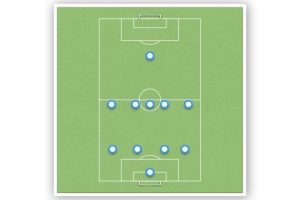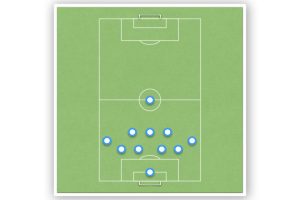4231 Formation Basics
The 4231 formation is a versatile and well-balanced formation that can be adapted for both attacking and defensive strategies. The formation can easily transition into a 4-4-1-1 or a 4-4-2, which are two of the most effective formations for defending due to their compactness. The space in front of the two blocks, normally where an opposition central defensive midfielder occupies, should be covered by one of the forwards.
The double pivot is a strength of this formation in both attack and defense. The wide midfielders are required to push up in support when attacking, which sometimes results in the team being caught out on the counter and the full backs being left isolated against both the opposition-wide attacker and fullback. However, the advantage with this formation is that even if an outside midfielder fails to come back in time, there is theoretically a defensive midfielder and fullback available to cover and buy time for the winger to come back.
Formation Overview
The 4231 formation is a versatile and well-balanced formation that offers both attacking and defensive variations. This formation can easily transition into a 4-4-1-1 or a 4-4-2, which are two of the most effective formations when defending due to their compactness.
On defense, the space in front of the two blocks, where an opposition Central defensive midfielder occupies, should be covered by one of the forwards. Strikers need to adjust their positions in a pendulum-like movement to avoid being outplayed with a single pass in between the lines. The advantage with this formation on defense lies in the double pivot, which allows for flexible combinations on both sides of the pitch.
When attacking, the double pivot allows for combinations that can be used to get out of tight situations. Having both left and right defensive midfielders means it is much easier to bring in a third man into play. The double pivots also move in a pendulum-like movement similar to the strikers. The player on the side of the ball gets involved in attacking combinations while the other covers and protects the two center-backs.
One interesting alternative is one of the center defensive midfielders dropping into the position of a fullback. This tactic is often used by Barcelona’s Frankie Dejong and Real Madrid’s Tony Kross to help their teams get out of tight situations when the opposition implements an active press in possession of the ball.
Wingers can tuck in and take positions in the half spaces to allow the fullback to push up to provide more attacking options. A central midfielder dropping into the left-back position creates confusion in the opposition midfield. This creates a domino effect of players being dragged out of position and exposing spaces behind them.
The central attacking players become key since the vertical alignment of the two attackers allows for both of them to drift to the same side and create numerical advantages. It is important for the number nine to keep the two center-backs engaged so that they can’t easily put pressure on the number 10, attacking midfielder who needs to make supporting runs on the side of the ball. This again drags center-backs out of position and exposes spaces behind them which should always be taken advantage of whenever possible.
Overall, the 4231 formation is a well-balanced formation that offers both attacking and defensive variations. Its strength lies in the double pivot, which allows for flexible combinations on both sides of the pitch.
Defensive Strategy
Transition to 4-4-1-1 or 4-4-2
The 4231 formation is a well-balanced formation that allows for both attacking and defensive variations. On defense, this formation can easily transition into a 4-4-1-1 or a 4-4-2, which are two of the most effective formations due to their compactness. The space in front of the two blocks, normally where an opposition central defensive midfielder occupies, should be covered by one of the forwards. Strikers need to adjust their positions in a pendulum-like movement to avoid being outplayed with a single pass in between the lines.
Role of Forwards
The advantage with the 4231 formation on defense lies in the double pivot. Since the formation plays with one striker, the wide midfielders are required to push up in support when attacking. This sometimes results in a team being caught out on the counter, and the full-backs are left isolated against both the opposition-wide attacker and full-back. However, the worst thing that can happen is that both strikers are outplayed with a single pass in between the lines, and the rest of the team is required to defend with two less players.
Double Pivot Advantage
The double pivot is also a strength of this formation in attack. By staying close to each other and with the help of the attacking midfielder, the double pivot allows for combinations that can be used to get out of tight situations. Having both the left and right defensive midfielder means it is much easier to bring in a third man into play, allowing for flexible combinations on both sides of the pitch. Generally, the double pivots also move in a pendulum-like movement similar to the strikers.
One interesting alternative is one of the center defensive midfielders dropping into the position of a full-back. This tactic is often used by Barcelona’s Frankie De jong and Real Madrid’s Tony Kroos to help their teams get out of tight situations when the opposition implements an active press in possession of the ball.
Wingers can tuck in and take positions in the half spaces to allow the full-back to push up to provide more attacking options. A central midfielder dropping into the left-back position creates confusion in the opposition midfield, since following their man will mean that they leave the center of the pitch to be exploited. This creates a domino effect of players being dragged out of position and exposing spaces behind them, which is why defenders especially are hesitant to follow their man into the spaces between the lines and choose to stay in their positions.
The central attacking players become key since the vertical alignment of the two attackers allows for both of them to drift to the same side and create numerical advantages. It is important for the number nine to keep the two center-backs engaged so that they can’t easily put pressure on the number 10 or attacking midfielder who needs to make supporting runs on the side of the ball. This again drags center-backs out of position and exposes spaces behind them, which should always be taken advantage of whenever possible since teams tend to dislike 1v1 situations at the back.
Often, a central midfielder will come out of position to support the center-backs, and this creates space in the midfield. The midfield overload needs to be taken advantage of quickly since one of the strikers often drops to support the midfield when defending. Using quick one-twos, the goal should be to get the ball into the box for a shot on goal before the opposition is able to reorganize. Even if the center-back is able to get there to cover, a 1v1 situation inside the box is still a serious advantage for the attacking team.
Attacking Strategy
Role of Wide Midfielders
In the 4231 formation, the wide midfielders play a crucial role in supporting the attack. However, when attacking, they must be careful not to leave the fullbacks isolated against the opposition-wide attacker and fullback. If an outside midfielder fails to come back in time, there is theoretically a defensive midfielder and fullback available to cover and buy time for the Winger to come back. Additionally, Wingers can tuck in and take positions in the half spaces to allow the fullback to push up to provide more attacking options.
Strength of Double Pivot in Attack
The double pivot is also a strength of the 4231 formation in Attack. By staying close to each other and with the help of the attacking midfielder, the double pivot allows for combinations that can be used to get out of tight situations. Having both the left and right defensive midfielder means it is much easier to bring in a third man into play, allowing for flexible combinations on both sides of the pitch. The player on the side of the ball gets involved in attacking combinations while the other covers and protects the two center-backs.
Flexible Combinations
The double pivot’s flexibility allows for a central midfielder to drop into the position of a fullback, creating confusion in the opposition Midfield. This creates a domino effect of players being dragged out of position and exposing spaces behind them, which is why Defenders especially are hesitant to follow their man into the spaces between the lines and choose to stay in their positions. The central attacking players become key since the vertical alignment of the two attackers allows for both of them to drift to the same side and create numerical advantages. It is important for the number nine to keep the two center-backs engaged so that they can’t easily put pressure on the number 10 attacking midfielder who needs to make supporting runs on the side of the ball.
Alternative Tactics
Role of Central Defensive Midfielders
In the 4231 formation, the space in front of the two blocks, normally occupied by an opposition central defensive midfielder, should be covered by one of the forwards. This requires the strikers to adjust their positions in a pendulum-like movement to avoid being outplayed with a single pass in between the lines. The double pivot in the formation is a strength in defense as it provides coverage in the midfield.
Impact of Wingers and Fullbacks
The formation plays with one striker, which requires the wide midfielders to push up in support when attacking. However, this can sometimes result in a team being caught out on the counter, leaving the fullbacks isolated against both the opposition-wide attacker and fullback. To counter this, one interesting alternative is to have one of the central defensive midfielders drop into the position of a fullback. Wingers can also tuck in and take positions in the half spaces to allow the fullback to push up and provide more attacking options.
Exploiting Spaces
The central attacking players become key in the formation, as the vertical alignment of the two attackers allows for both of them to drift to the same side and create numerical advantages. It is important for the number nine to keep the two center-backs engaged, allowing the number 10 or attacking midfielder to make supporting runs on the side of the ball. This drags center-backs out of position and exposes spaces behind them, which should always be taken advantage of whenever possible. The midfield overload needs to be taken advantage of quickly, using quick one-twos to get the ball into the box for a shot on goal before the opposition can reorganize.
Central Attacking Players
Role of Number Nine
In the 4231 formation, the central attacking players play a crucial role in creating numerical advantages and exposing spaces behind the opposition defense. The number nine is responsible for engaging the two center-backs and keeping them occupied, which allows the attacking midfielder or number ten to make supporting runs on the side of the ball. This creates confusion in the opposition defense and often results in central midfielders coming out of position to support the center-backs, which creates space in the midfield. The aim is to take advantage of these spaces quickly using quick one-twos and get the ball into the box for a shot on goal before the opposition can reorganize.
Supporting Runs by Number Ten
The number ten or attacking midfielder in the 4231 formation plays a crucial role in supporting the number nine and creating numerical advantages. The vertical alignment of the two attackers allows for both of them to drift to the same side and create numerical advantages. The number ten needs to make supporting runs on the side of the ball, which drags center-backs out of position and exposes spaces behind them. This creates opportunities for the attacking team to exploit and take advantage of. The central attacking players need to work together to create these opportunities and take advantage of them quickly before the opposition can reorganize.
Overall, the central attacking players in the 4231 formation are crucial in creating numerical advantages and exposing spaces behind the opposition defense. The number nine and number ten need to work together to create these opportunities and take advantage of them quickly to score goals.
Midfield Overload
Quick One Twos
When playing against a 4-2-3-1 formation, it is important to take advantage of the midfield overload quickly. One of the strikers often drops to support the midfield when defending, leaving space behind. The best way to exploit this is by using quick one-twos to get past the opposition and into the box for a shot on goal. Even if the center-back is able to get there to cover, a 1v1 situation inside the box is still a serious advantage for the attacking team.
Goal of Getting the Ball into the Box
The goal of the attacking team should be to get the ball into the box for a shot on goal before the opposition is able to reorganize. The 4-2-3-1 formation is a flexible and well-balanced formation that allows for both attacking and defensive variations. On defense, this formation can easily transition into a 4-4-1-1 or a 4-4-2, which are two of the most effective formations when defending due to their compactness.
The space in front of the two blocks, normally where an opposition central defensive midfielder occupies, should be covered by one of the forwards. Strikers need to adjust their positions in a pendulum-like movement since the worst thing that can happen is that they are both outplayed with a single pass in between the lines and the rest of the team is required to defend with two less players.
The advantage with this formation on defense lies in the double pivot since the formation plays with one striker. The wide midfielders are required to push up in support. When attacking, this sometimes results in a team being caught out on the counter and the full-backs are left isolated against both the opposition-wide attacker and fullback.
The double pivot is also a strength of this formation in attack. By staying close to each other and with the help of the attacking midfielder, the double pivot allows for combinations that can be used to get out of tight situations. Having both the left and right defensive midfielder means it is much easier to bring in a third man into play, allowing for flexible combinations on both sides of the pitch.
Generally, the double pivots also move in a pendulum-like movement similar to the strikers. The player on the side of the ball gets involved in attacking combinations while the other covers and protects the two center-backs. One interesting alternative is one of the center defensive midfielders dropping into the position of a full-back. Barcelona’s Frankie Dejong and Real Madrid’s Tony Kroos are two players who implement this tactic often to help their teams get out of tight situations when the opposition implements an active press in possession of the ball.
Wingers can tuck in and take positions in the half spaces to allow the full-back to push up to provide more attacking options. A central midfielder dropping into the left-back position creates confusion in the opposition midfield since following their man will mean that they leave the center of the pitch to be exploited. This creates a domino effect of players being dragged out of position and exposing spaces behind them, which is why defenders especially are hesitant to follow their man into the spaces between the lines and choose to stay in their positions.
Frankie Dejong, in particular, likes to dribble past his opposition and is able to continue driving forward with the ball to participate further in attacking play. Further up the pitch, the central attacking players become key since the vertical alignment of the two attackers allows for both of them to drift to the same side and create numerical advantages.
It is important for the number nine to keep the two center-backs engaged so that they can’t easily put pressure on the number 10 or attacking midfielder who needs to make supporting runs on the side of the ball. This again drags center-backs out of position and exposes spaces behind them, which should always be taken advantage of whenever possible. Since teams tend to dislike 1v1 situations at the back, often a central midfielder will come out of position to support the center-backs, and this creates space in the midfield.







